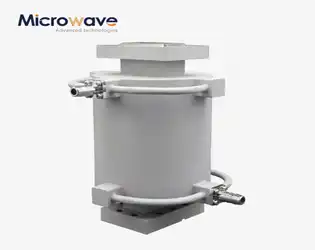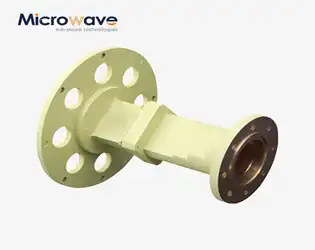BLOG

How Does Customizable Twist Angle Enhance the Performance of Water-cooled Twist Waveguides?
June 27, 2025
In the realm of high-frequency microwave systems, the optimization of signal transmission while managing thermal challenges has become increasingly critical. The Water-cooled Twist Waveguide represents a sophisticated solution that addresses both electromagnetic performance and thermal management through innovative design approaches. The customizable twist angle feature in these waveguides serves as a pivotal element that significantly enhances overall system performance by enabling precise polarization control, impedance matching, and spatial configuration flexibility. This advanced engineering capability allows engineers to tailor waveguide characteristics to specific application requirements, ultimately resulting in superior signal integrity, reduced losses, and enhanced operational reliability across diverse microwave communication systems.
How to Optimize Radar System Performance with Advanced Waveguide Transitions?
June 27, 2025
In the rapidly evolving landscape of radar technology, achieving optimal system performance requires sophisticated engineering solutions that address the complex challenges of signal transmission, thermal management, and electromagnetic compatibility. Modern radar systems demand exceptional precision and reliability, particularly in defense, aerospace, and satellite communication applications where performance degradation can have critical consequences. The key to unlocking superior radar performance lies in implementing advanced waveguide transitions that seamlessly integrate cutting-edge cooling technologies with precision-engineered transmission components. These specialized components serve as the backbone of high-power radar systems, ensuring minimal signal loss while maintaining operational stability under extreme conditions. Advanced Microwave Technologies Co., Ltd has pioneered innovative solutions in this field, developing state-of-the-art waveguide transition technologies that revolutionize how radar systems handle power distribution and signal integrity across diverse operational environments.
How Do Corrugated Horn and Multimode Horn Antennas Deliver Superior High-Frequency Support?
June 27, 2025
In today's rapidly evolving telecommunications landscape, the demand for reliable high-frequency communication systems has never been greater. Corrugated Horn and Multimode Horn Antennas stand at the forefront of this technological revolution, offering unparalleled performance in challenging frequency ranges. These sophisticated antenna designs utilize advanced waveguide technology to achieve superior signal transmission characteristics, making them indispensable for satellite communications, aerospace applications, and defense systems. Through their unique structural configurations and precision engineering, these antennas deliver exceptional gain, minimal signal loss, and stable performance across wide frequency bands, addressing the critical needs of modern high-frequency applications.
How Can the Waveguide Adjustable Support Improve Antenna Performance?
June 27, 2025
In modern microwave and antenna systems, achieving optimal performance requires precise mechanical stability and accurate alignment of all components. The Waveguide Adjustable Support emerges as a critical component that directly influences antenna performance through its ability to maintain structural integrity and enable fine-tuned positioning. This specialized support system addresses fundamental challenges in waveguide installations, where even minor misalignments can result in significant signal degradation, increased insertion loss, and compromised overall system efficiency. Understanding how the Waveguide Adjustable Support enhances antenna performance is essential for engineers and system designers working with satellite communications, radar systems, and telecommunications infrastructure where precision and reliability are paramount.
How to Reduce Signal Reflection with Double Ridge Waveguide Termination?
June 26, 2025
Signal reflection remains one of the most critical challenges in high-frequency microwave systems, particularly in applications requiring precise signal integrity across wide bandwidths. The Double Ridge Waveguide Termination emerges as a sophisticated solution designed to address these reflection issues while maintaining optimal performance across diverse frequency ranges. This advanced component serves as a crucial element in modern waveguide systems, effectively absorbing unwanted signals and preventing reflections that could compromise system performance. The technology behind these terminations combines innovative ridge waveguide geometry with precision engineering to deliver superior electrical characteristics, making them indispensable for applications in satellite communications, radar systems, and telecommunications infrastructure where signal fidelity is paramount.
How Can Active Limiter Transform Your Aerospace Communication System's Reliability and Performance?
June 26, 2025
In the demanding environment of aerospace communication systems, protecting sensitive microwave components from power surges and interference is paramount to mission success. Active Limiter technology represents a revolutionary approach to enhancing system reliability by intelligently managing power levels while maintaining signal integrity. These sophisticated devices act as intelligent guardians, automatically detecting and limiting excessive power that could potentially damage critical communication equipment. By implementing Active Limiter solutions, aerospace engineers can ensure continuous, stable signal transmission while safeguarding expensive hardware investments. The integration of Active Limiter technology transforms traditional communication systems into robust, self-protecting networks capable of operating reliably in the harshest space environments where equipment failure is not an option.
June 26, 2025
Signal reflections pose a significant challenge in high-frequency communication systems, particularly those operating at 110 GHz frequencies. Waveguide unmatched termination emerges as a critical solution for managing these unwanted reflections while maintaining optimal system performance. Unlike traditional matched loads that aim for perfect impedance matching, unmatched terminations are specifically designed to provide controlled reflection characteristics that serve specific engineering purposes. These specialized components offer engineers precise control over reflection coefficients, enabling them to fine-tune system behavior in complex microwave applications. By strategically implementing waveguide unmatched termination solutions, communication systems can achieve enhanced signal stability, reduced interference, and improved overall performance across the millimeter-wave spectrum.
How Can a Water-cooled Twist Waveguide Improve High-Power Microwave System Stability?
June 26, 2025
In high-power microwave systems, thermal management represents one of the most critical challenges affecting operational stability and component longevity. The Water-cooled Twist Waveguide emerges as a revolutionary solution that addresses this fundamental issue by combining advanced cooling technology with precision-engineered waveguide design. This innovative component effectively manages heat dissipation while maintaining exceptional electromagnetic transmission performance, ensuring that high-power microwave systems operate with enhanced stability, reduced signal degradation, and extended operational lifespans. The integration of water-cooling mechanisms within twist waveguide structures creates a synergistic approach that not only prevents thermal-induced failures but also maintains consistent impedance characteristics and minimizes reflection losses, making it indispensable for modern radar systems, satellite communications, and telecommunications infrastructure where reliability and precision are paramount.




